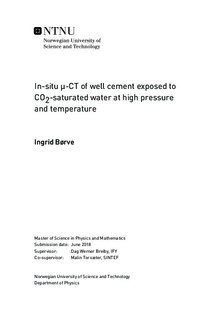| dc.description.abstract | Large-scale implementation of carbon dioxide (CO2) sequestration in depleted oil and gas reservoirs may potentially mitigate global climate change. However, successful CO2 storage is contingent on a limited leakage through abandoned wells, which are commonly sealed with Portland cement. Thus, with the purpose of assessing depleted oil and gas reservoirs as sites for CO2 sequestration, it is of interest to evaluate the degradation of Portland cement when subjected to CO2 at reservoir conditions.
In this study, in-situ synchrotron micro computed tomography (µ-CT) images of Portland G cement exposed to CO2-saturated water at high pressure and temperature have been analyzed with the aim of obtaining an enhanced understanding of the cement carbonation process. The cement sample had a through-going cavity that served as an idealized CO2 leakage pathway during the µ-CT experiment, and alternating nonflow and constant flow conditions of CO2-saturated water were applied. Automatic procedures have been developed to segment and further analyze the digital three-dimensional images. The results showed that in-situ µ-CT with synchrotron radiation is an experimental technique well-suited for gaining insight into the dynamics of cement carbonation.
The µ-CT images revealed processes occurring in the cement sample in the course of the experiment. Cement reaction zones were seen to develop near CO2--cement interfaces, and the growth rate of reacted cement was found to be faster for CO2 flow compared to static conditions. Moreover, the results suggested that the growth of reacted cement slows down with time given constant CO2 conditions. The images showed that crystals of calcium carbonate precipitated in the CO2 leakage path during the first period of static CO2 conditions. During time intervals of CO2 flow, on the other hand, the crystals re-dissolved. The volumetric dissolution rate was approximately linear as function of time for constant CO2 flow conditions, and it was found to increase when the CO2 flow rate was raised. Furthermore, the measurements indicated that the cement sample experienced a slight expansion in the course of the experiment.
The obtained results seem promising for the integrity of CO2 wells in the case of static CO2 conditions, attributed to the slow cement carbonation and the cavity self-healing observed. However, the results suggest a relatively fast cement degradation and re-opening of cavities for cement exposed to CO2 at a constant flow rate, which indicates that the sealing ability of wells may become compromised if well cement is exposed to a rapid CO2 flow over time. | |

